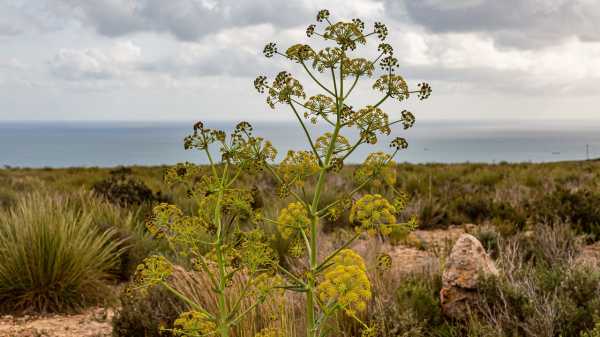
Europeans in India called it Devil’s Dung. It is perhaps the most stinky spice in the world. Even its name includes “fetid,” as fair warning. Yet Indians have been devoted consumers of asafetida since ancient times, using pinches of it to aid in the digestion of beans and vegetables. There is a story from sixteenth-century India—found in “Hobson-Jobson,” an essential glossary of Anglo-Indian words and phrases—about a Portuguese man who had a horse of great value that the king wanted to buy, except that the animal had a bad case of flatulence. When the owner cured the horse by feeding it asafetida, the king exclaimed, “ ’Tis nothing then to marvel at for you have given it to eat the food of the gods.” To which the Portuguese man, no fan of the sulfurous spice, replied, “Better call it the food of the devils!”
Asafetida, or heeng in Hindi, is a resin, yellowish-white and sticky. A lump of it reminds me of the rosin that my violinist husband uses on his bow to help draw out the sound of his instrument’s strings. But, whereas rosin comes from tapping common pine trees, the gum resin for asafetida is extracted from the lower stem and roots of a rare wild member of the carrot family. The plant requires a cold climate, arid but sunny. It is found mostly in the desert-like higher regions of Afghanistan, Kazakhstan, Uzbekistan, and Iran. It is very finicky and grows stubbornly on its own. Many believe that it was being imported to India as early as 600 B.C.
In India, asafetida resin is “stabilized” with the addition of an edible substance, such as wheat or rice flour, and then formed into lumps, granules, and powders. I remember my mother would buy only the “purest” lump of asafetida. She would hack off a tiny piece, cover it with cotton wool, hold it with tongs over a flame to roast it—the burning cotton helped control the browning process—and then crush it into a powder. My mother’s mother and grandmother had done the same before her, and had passed down knowledge of the resin’s medicinal aspects. In folklore and mythology, asafetida can chase away evil spirits. In modern medicine, it is used to help treat ulcers, asthma, and bronchitis. My mother knew the spice’s sulfur compounds as an antiseptic, an antispasmodic, a digestive, a diuretic, an expectorant, a sedative, and a laxative.
What mattered most to us children was that my mother’s store of information led her to prepare the most luscious of foods. When I left India and went to London as a drama student, in my early twenties, I did not know how to cook at all. I was homesick, and my homesickness took the form of a deep longing for Indian food. I wrote to my mother for recipes, and among the first I asked for was potatoes cooked with asafetida and cumin. The broth, which included tomatoes, was heaven. To me, that was the taste of home. When a cousin came to visit, my mother sent her with a lump of asafetida in a tightly sealed box. I still have it, almost fifty years later, and it still smells.
What is it about asafetida that so haunts the senses? Many spices and seasonings change when they are toasted. Cumin seeds turn nutty. Chili skins turn dark red and deepen in flavor. But something almost miraculously transformative happens to asafetida when it hits hot oil or ghee. It is generally combined, always in small amounts, with other seasonings in a cookery step known in northern India as tarka. To make my version, I put two tablespoons of ghee into a small frying pan and let it get really hot. Then I put in a generous pinch of ground asafetida, which sends up its sulfurous and fart-like funk. Within seconds, I add a quarter teaspoon of whole cumin seeds and a whole hot dried chili. Then I swirl the pan around and immediately pour the mixture into a pot of freshly cooked, still-hot beans or lentils. I put the lid on quickly to entrap all the aromas and flavors. What happens next is as if some pesky person had farted and then slyly left the kitchen. The smell may linger, but inside the pot the asafetida odor vanishes and is replaced by something tantalizing and new.
When James Beard was getting old, I helped him teach his last classes, at his house in the West Village, down the block from me. The subject was “taste.” We sampled all sorts of foods—caviars, meats, oils, salts—with students wearing blindfolds to see what they could identify and what they liked. After one class, when Beard and I were relaxing with friends, I asked him to smell and taste asafetida, freshly dropped into hot oil. He sniffed the air and said immediately, “Truffles! It’s truffles.”
A few years ago, with trading routes in Afghanistan, India’s main exporter, disrupted, Indians began to consider the unthinkable: they would grow asafetida on their own. The process takes four to five years. The plants go dormant at the first sign of unhappiness. Seeds were bought from Iran. Cold, desert-like regions of India’s western Himalaya mountains were selected for trials. The plants are now in their second year of growth. Indians are praying that sooner or later their beloved “truffles” will bloom.
Sweet, Sour, and Spicy Black-Eyed Peas
Serves 4–5
Ingredients
-
1 ½ cups dried black-eyed peas
-
3 medium tomatoes
-
3 Tbsp. ghee (clarified butter), peanut oil, or olive oil
-
1 to 3 whole dried hot red chilies, depending on desired heat
-
½ tsp. whole black mustard seeds (available at Indian markets and specialty grocers)
-
½ tsp. whole cumin seeds
-
Generous pinch of ground asafetida
-
15 fresh curry leaves, if you can find them at a specialty store
-
¼ tsp. ground turmeric
-
1 tsp. ground coriander
-
1 tsp. ground cumin
-
2 tsp. finely grated, peeled fresh ginger
-
2 tsp. finely grated or crushed garlic (2 large cloves)
-
1 ½ tsp. sugar
-
1 ½ tsp. Diamond Crystal kosher salt
-
Handful of cilantro leaves, for garnish
Directions
1. Put the black-eyed peas in a bowl. Wash in several changes of water and drain.
2. Soak the peas in 4 cups water overnight. Drain them the next morning and put them in a medium-sized pan. Add 4 ½ cups water and bring to a boil. Do not let it boil over. Remove as much of the white froth as you can with a skimmer or slotted spoon, cover partially and simmer gently for about 50 minutes or until the peas are soft but still retain their shape. Older black-eyed peas will take longer.
3. While the peas cook, grate the tomatoes into a bowl: cut the caps off the tomatoes. Using the coarsest side of a box grater, start grating the tomatoes at the cap end and keep going until your hand is almost flat against the grater and only the tomato skin remains. Do all the tomatoes. Ready all your other ingredients.
4. Once the black-eyed peas are cooked, set them aside. Take a medium-sized nonstick frying pan. Pour in the ghee or oil and set the pan on medium-high heat.
5. When the ghee is hot, put in the red chilies, mustard seeds, cumin seeds, and asafetida. As soon as the mustard seeds start to pop (a matter of seconds), stir once and add the curry leaves, if using. They will splatter a bit, so stand back. Add the tomatoes. Stir a few times. Add the turmeric, coriander, cumin, ginger, garlic, sugar, and salt.
6. Keep stirring and cooking until you see the ghee glimmering along the edges and on the top. Add all the ingredients in the frying pan to the pan with the black-eyed peas. Bring to a boil. Cook, uncovered, stirring now and then, over medium heat for 20 minutes, or until the liquid creates a thin film above the peas.
7. Garnish with the cilantro leaves. The peas can be served in a bowl with rice or a bread such as naan or pita. Plain yogurt lightly seasoned with salt and pepper and a quick salad of chopped onions, cucumbers, and tomatoes are nice accompaniments. ♦
Sourse: newyorker.com






